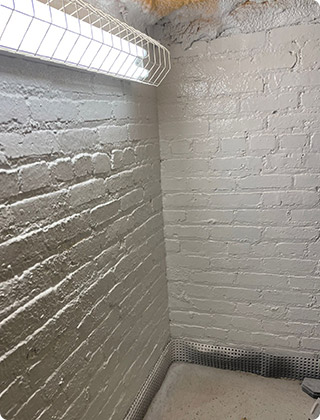
Does Mold Resistant Paint Work?
You've got mold stains creeping along the ceiling. Maybe it's your bathroom, maybe the basement - either way, it's frustrating, and you're wondering:
Can I just paint over this and be done with it?
A lot of homeowners turn to mold resistant paint hoping it'll stop mold in its tracks. The idea sounds perfect: slap on a special coating and keep the mold away for good. But here's the thing - it's not always that simple.
Mold resistant paint can help, but only if it's used the right way, in the right conditions, and after you've addressed the actual source of the mold. If you skip that step, you could end up wasting time, money, and worse - letting the problem grow behind the scenes.
This guide will walk you through what mold resistant paint can do, what it can't, and how to tell if it's even the right move for your home. We'll also explain when it's time to call in certified mold inspectors, like our team at O2 Mold Testing, to make sure you're not just covering up a deeper problem.
What Is Mold Resistant Paint?
Mold resistant paint looks like regular paint, goes on like regular paint - but it's got one key difference: it's made to help stop mold from growing on the painted surface.
How? It's all in the formula. Mold resistant paints are blended with antimicrobial agents - additives that make it harder for mold spores to take hold. These ingredients create a surface that's hostile to mold and mildew, especially in damp, humid places like bathrooms, laundry rooms, and basements.
But here's what many homeowners don't realize: mold resistant paint is designed to prevent mold from forming on clean, dry surfaces. It doesn't kill existing mold. It won't fix a leak behind the wall. And it can't block moisture or mold that's already inside the structure.
There is some solid research behind these paints. Studies have shown that antimicrobial coatings can reduce surface mold growth - when used correctly. But for them to work, you need to apply the paint in the right conditions: no hidden moisture, no active mold, and a surface that's been properly cleaned and prepped.
So yes, mold resistant paint can be effective. But it's not a cure-all - it's a tool. And like any tool, it only works when the real problem has been handled first.
How Mold Resistant Paint Works
Mold resistant paint works by creating a surface that resists mold spores. When applied correctly, it forms a barrier that makes it difficult for spores to settle, grow, or penetrate through to the wall underneath.
But here's what it doesn't do - and this is where many homeowners get tripped up:
Mold resistant paint will not:
- Kill existing mold growing on the surface
- Remove stains, smells, or mold damage
- Fix moisture problems like roof leaks, burst pipes, or condensation
- Block mold that's growing behind drywall or inside walls
- Prevent mold in high-humidity areas without proper ventilation
It also won't fix what's feeding the mold in the first place. If there's a moisture issue - like a leak, poor airflow, or trapped humidity - no paint, no matter how advanced, will solve it alone.
Another important factor? Application. To get the protection these paints offer, the surface has to be dry, mold-free, and prepped properly. In most cases, you'll also need multiple coats and possibly a primer made for moisture-prone areas. Skipping steps here can mean wasting time and money and still ending up with the same mold problem later.
Can Mold Resistant Paint Prevent Mold?
Yes - but only to a point.
Mold resistant paint can provide surface-level protection. If your walls are clean, dry, and mold-free to begin with, this kind of paint can help slow down future growth, especially in rooms with occasional humidity like bathrooms or laundry areas.
But it can't do miracles. We've seen it firsthand. A homeowner in one of our service areas painted over a moldy patch in their basement with a high-end "mold-proof" paint. It looked fine for a few weeks. But the source of the moisture - a slow foundation leak - hadn't been addressed. Within a month, dark spots started reappearing, the paint began to bubble, and the musty smell came back even stronger. They ended up needing full remediation and testing, which could have been avoided with a proper inspection up front.
So yes, mold resistant paint has a role to play. But without fixing the moisture source or confirming there's no hidden mold, it's a short-term cover - not a long-term solution.
Common Mold Paint Myths
There's a lot of confusion around mold resistant paint - mostly because it sounds like a cure-all. But if you're dealing with an active mold issue, painting over it is more likely to make things worse than better. Let's clear up the biggest misconceptions:
Myth #1: Mold resistant paint is a mold remediation solution
It's not. Remediation involves identifying the cause, removing the mold safely, and ensuring it doesn't return. Paint doesn't do any of that. It's a finish, not a fix.
Myth #2: You can paint over mold to seal it in
Painting over mold won't stop it from growing. It may cover the stains temporarily, but mold can continue to thrive underneath - and you won't see it until the damage is worse.
Myth #3: Mold resistant paint works in any condition
These paints are only effective when applied to a properly cleaned, dry, mold-free surface. Slapping on a coat without fixing the moisture problem underneath is like putting a bandage on a leak.
The truth?
Mold resistant paint is a preventive measure. It's meant to be used after the real problem has been handled - ideally after a certified inspection confirms that the area is clean and dry. It's not a stand-alone solution, and it never replaces professional mold removal.
When to Use Mold Resistant Paint
Mold resistant paint does have its place - but only if the conditions are right. It's designed to work as a preventive layer, not a cover-up. So if you're planning to use it, timing and location matter.
Best places to use mold resistant paint:
- Bathrooms with poor ventilation
- Kitchens with steam or cooking humidity
- Laundry rooms with washer/dryer moisture buildup
- Basements with some humidity (but no leaks)
- Garages and utility rooms
- Attics that stay warm or damp
These are all areas where moisture tends to linger, and mold resistant paint can help reduce surface growth after the space has been properly cleaned and dried.
But - and this is important - paint should never be your first step. Before you reach for a roller, ask yourself:
- Is there any sign of musty odor or discoloration?
- Has the area had a leak, flood, or HVAC issue?
- Have you checked for mold behind the walls or under flooring?
If there's even a slight chance of hidden mold, it's time to pause. A professional mold inspection can pinpoint whether there's an underlying issue - and if so, what needs to be fixed before painting even starts.
We see it all the time: people spend money on the best anti-mold paint, only to watch the problem return because they painted over a deeper issue. Don't let that be you. A certified inspection now can save you hundreds - or thousands - later.
Why Mold Keeps Coming Back After Painting
If you've already tried painting over mold and watched it reappear weeks or months later, you're not alone. It happens all the time - not because the paint was low quality, but because the real issue was never addressed.
Mold thrives on moisture. And that moisture can be hiding just about anywhere: behind drywall, under floorboards, around windows, or in poorly ventilated attic spaces. You may not see it, but mold doesn't need a flood to grow - even a small, unnoticed leak or trapped humidity is enough to create the perfect environment.
Many homes also suffer from poor insulation or ventilation, which leads to condensation. When warm, damp air can't escape, it settles onto cooler surfaces - and that's exactly where mold starts to take hold. You could repaint over it every season, but if the airflow and insulation issues aren't corrected, the mold will keep returning.
This is the part that trips most people up: mold isn't just a surface problem. It's a sign that something in your home - structurally or environmentally - needs attention. And paint, no matter how advanced or expensive, only addresses the surface. It doesn't fix what's happening underneath.
That's why, at O2 Mold Testing, we always tell our clients to hold off on the paint until they're absolutely sure the root cause has been found and corrected. Because once the mold's coming from inside the structure, it's no longer a cosmetic issue - it's a building health problem.
How We Solve the Real Problem
At O2 Mold Testing, we don't guess - we investigate. If mold keeps coming back or you're not sure where it's hiding, the first step is getting a clear picture of what's really going on behind the walls, not just on them.
Our certified inspectors start with a detailed visual assessment, looking for signs of mold growth, water intrusion, and areas of concern that most homeowners (and painters) overlook. From there, we conduct air and surface testing to detect mold spores you can't see - the kind that circulate through your home's air and land where conditions are just right for growth.
We also use moisture detection tools to map out where water may be trapped - whether it's from a past leak, high humidity, or improper ventilation. Once we have all the data, we provide you with a full report outlining the problem, the cause, and the steps needed to correct it.
This process gives you answers, not guesses. No unnecessary demolition, no surprises later. Just real information so you can decide what to do next - whether that's remediation, repairs, or yes, even painting.
Professional Advice Before You Paint
If you're thinking about using mold resistant paint, here's the best advice we can give: don't paint blind. Before you cover anything up, make sure you're not sealing in a hidden mold problem - because once it's painted over, it becomes harder (and more expensive) to deal with later.
A certified inspector doesn't just look for visible mold. We check for signs most people miss - subtle water stains, warped materials, air quality issues, and humidity pockets that paint can't protect against. With expert mold inspection and moisture testing, we can pinpoint problems before they get worse.
Testing before painting gives you confidence. You'll know exactly what's behind the walls, whether the area is safe to seal, and if any action needs to be taken first. Skipping this step may save a little time, but it often leads to bigger repairs, health concerns, and repeat paint jobs.
When in doubt, get professional mold advice. One inspection now can protect your home - and your wallet - from mistakes that a gallon of paint won't fix.
Need a Mold Check Before Painting?
Before you break out the roller and paint tray, make sure you're not covering up a problem that could cost you more down the line. A certified mold inspection from O2 Mold Testing gives you peace of mind - and a clear path forward.
Our team offers fast scheduling, thorough inspections, and lab-tested results you can trust. Whether you're prepping for a renovation or trying to make sure your home is mold-free before painting, we've got you covered.
Book your expert mold inspection today through our website or give us a call. Let's make sure your next coat of paint goes on clean, safe, and worry-free.


